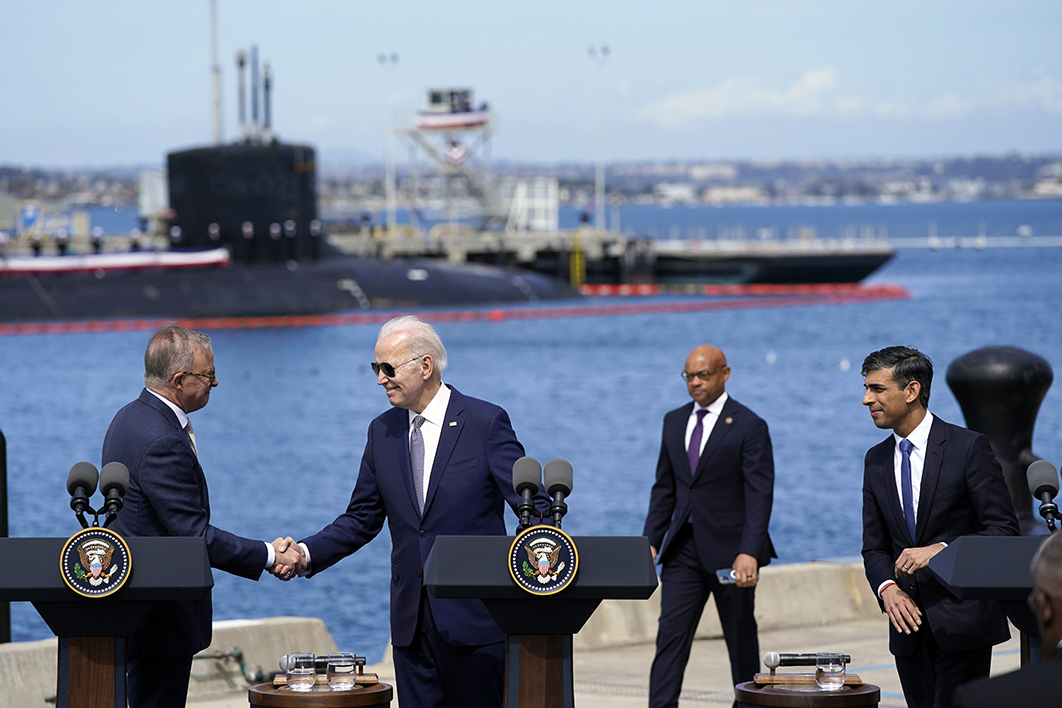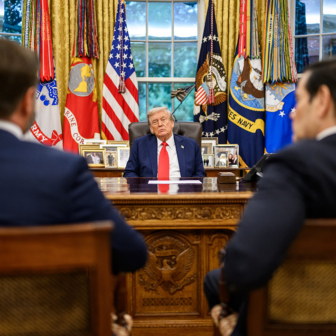This week’s tri-nation announcement by Joe Biden, Rishi Sunak and Anthony Albanese kicks the Royal Australian Navy’s acquisition of the subs far into the future. The navy has a wait of a decade or more before the first nuclear-powered submarine is handed over.
The deal developed by the RAN’s vice-admiral Jonathan Mead and his project team, and accepted by the Albanese cabinet, is like a boy given carte blanche in a toy shop: we’ll have three to five of the US-model Virginia-class subs; then eight or more of the British follow-on to the existing Astute-class, to be built in Adelaide.
Albanese insists that Australian “sovereignty” will be paramount. But until 2033 or so, Australia will be protected in large part by US Navy and Royal Navy nuclear submarines patrolling out of the RAN’s Cockburn Sound base near Perth. The base will be expanded at a cost of $1 billion to accommodate them.
Only in 2033 will the RAN get its first nuclear-powered submarine, a Virginia-class boat transferred from the United States. It is unclear whether this — or the next two, three or four subs — will be new or second-hand. That will depend on how quickly the two US shipyards building the Virginia-class can ramp up production beyond the two per year demanded by the US Navy and concerned members of the US Congress.
To this end, Biden is asking Congress for US$4.6 billion. Canberra will be putting in A$3 billion, with a bit of that going to the British submarine yard at Barrow-in-Furness.
Rather than building new slipways, the extra capacity will be created by introducing a nightshift at the American yards. With US unemployment at a record low and the yards paying somewhat miserly wages to new staff, that might be hard to achieve. Australia is also hoping to rotate workers from Adelaide into the US and British yards to gain experience.
American experts think the transferred submarines will be second-hand, probably from the third and fourth production “blocks” commissioned since 2014. This means some will have as few as fourteen years remaining of their thirty-three-year reactor life when they are transferred in 2033 and beyond.
The price tag is put at somewhere between A$268 billion and A$368 billion over thirty years. The government insists that the initial $9 billion, over the next four years, won’t be felt at all: it will be met by $6 billion that would otherwise have gone to the cancelled French conventional submarines and $3 billion carved out of other defence programs. Expect protests over the latter, especially from the army, which is likely to see its heavy armour cut back.
The San Diego announcement by the three leaders has been greeted by a display of bipartisanship. The Coalition claims AUKUS as its own initiative, under the helmsmanship of Scott Morrison. But once it comes to finding the money — likely to be equivalent to 0.15 per cent of Australia’s gross domestic product each year — the bipartisanship will start to fray.
Opposition leader Peter Dutton has already nobly offered to support cuts to the National Disability Insurance Scheme and aged care to fit the bill. Expect some in Labor and the crossbenches to suggest the stage-three tax cuts and the capital gains tax discount are fairer sacrifices. What better excuse than national security and the Chinese peril for breaking election promises?
The biggest loser in the short term is South Australia. It is left with only the two-year-long refurbishments of the RAN’s Collins-class conventional submarines, one by one from 2026, when the first boat, the HMAS Collins, reaches thirty years in service.
Further work depends on progress in the joint British, US and Australian design work on the Astute-class follow-on submarine, known as the SSN-AUKUS. If it is ready to build, the first steel will be cut and laid down in the early 2030s and the first submarine commissioned in the early 2040s, with the rest to follow into the late 2050s. It is unclear whether the US will build some of these AUKUS submarines for itself, or continue developing the Virginia-class successor, known as the SSN (X).
BAE Systems has taken nine to eleven years to complete each of the seven Astutes for the Royal Navy, as against just under seven years for the American yards to turn out a Virginia-class boat. That relative slowness has already given rise to doubts about the promised schedule and cost of what is an entirely new design.
“Defence does not have a strong record in this area and the navy in particular has struggled to maintain design discipline,” Peter Dean, a professor and defence expert at Sydney University’s US Studies Centre, wrote in the Nine papers. “Constant design changes have slowed projects, frustrated industry and blown out budgets,” Dean went on.
BAE Systems is also running the $45 billion program for nine Hunter-class frigates. They were originally priced at $30 billion, and the first was supposed to be laid down in Adelaide last year but work has not yet commenced. The frigate “was supposed to bring synergies by sharing the design between the UK, Canada and Australia,” wrote Dean. “But this project has blown out the budget, hit delays and fractured its initial approach as the design has constantly been modified, raising concerns about its viability.”
Former Coalition foreign minister Alexander Downer, for one, thinks the 40 per cent cost savings of building the SSN-AUKUS submarines overseas rather than in Adelaide will be tempting for a future government. “Assuming South Australia’s relative decline in its share of the national population will continue,” Downer wrote in the Australian Financial Review this week, “federal governments will become less concerned about holding a diminishing number of seats in South Australia and more concerned about how they’re going to pay for their other expensive and right-on plans.”
It’s tough, but Adelaide has declined the chance of sending a fourth generation of the Downer dynasty to Canberra.
Cameron Stewart, a former defence signals analyst who is now one of the Australian’s best strategic commentators, thinks it could go further than this, and Rishi Sunak or his successor could be in for the kind of treatment Morrison meted out to France’s Emmanuel Macron.
The decision to go for the British design is “madness,” he wrote. “After Australia has done all of the very hard work — overcoming the regulations, the red tape, the export control, the politics — in securing a system whereby we can acquire three to five Virginia-class submarines from Washington, it gives it all up. For what? To help build from scratch in Adelaide a completely separate next-generation British designed nuclear-powered submarine.”
“This all but guarantees a future nightmare of massive delays, development risk, price blow-outs and schedule nightmares — everything that we see on every first-of-type submarine project around the world,” Stewart went on. It would be better just to keep on acquiring Virginia-class submarines rather than making a “needless U-turn” to keep Adelaide and the British happy.
The long schedule at least means that if the balloon goes up over Taiwan — as feared within the next three years by the hawkish thinkers recently assembled by the Nine papers in their “Red Alert” series — conflict between the United States and China will happen without us being able to do much about it, nor China paying us much attention.
We still await a formal statement to parliament and the Australian people outlining why we need these very large submarines with the capability to cruise to China’s nearby waters and bombard it with cruise missiles. Defence of the archipelagic approaches to Australia will be left to smaller, silent conventional submarines: our own Collins-class for a while and then perhaps with some help from the Indonesian, Singaporean and Vietnamese navies. •




